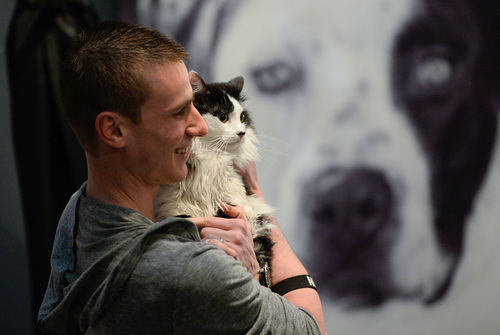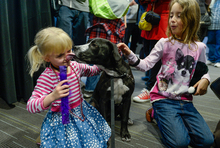This is an archived article that was published on sltrib.com in 2014, and information in the article may be outdated. It is provided only for personal research purposes and may not be reprinted.
Utah shelters are "bit by bit" killing fewer cats and dogs than they were 15 years ago, but Best Friends Animal Society on Sunday announced a new campaign to make Utah a no-kill state by 2019.
No-Kill Utah was launched before 100 cheering shelter workers and animal advocates at The Leonardo in Salt Lake City.
"It's possible to save all the animals," said Gregory Castle, chief executive of Best Friends, which has the nation's largest no-kill sanctuary in Kanab. "This is the final push."
Best Friends will kick in $1 million and 36 other Utah-based animal welfare groups are also part of the initiative.
Only New Hampshire now meets the criteria to claim it is a no-kill state, meaning that 90 percent of the animals that enter shelters leave alive. The other 10 percent are typically too sick or behaviorally challenged to be adopted.
The Utah initiative is modeled on a similar one in Los Angeles, which began in 2012. That city is well on its way to no-kill status by 2017, Castle said.
Utah cities and counties in 2013 saved 70 percent of the animals that they sheltered; 23 of the state's 56 shelters already have reached no-kill status.
Since animal advocates began working on the problem in Utah two decades ago, the percentage of animals both entering and dying in shelters has dropped substantially, Castle said.
Mass-adoption efforts and spay-neuter campaigns have been effective, he said.
In 1999, Utah's 56 shelters took in 81,000 animals. Last year, they took in 62,000.
Utah was killing 46,000 animals per year in shelters when the No More Homeless Pets initiative began in 1999. Last year, 18,000 were put to death.
Some cities and counties already can claim no-kill status. Washington County was the first to attain it last year, followed by West Valley City and Salt Lake County.
Castle was joined at the initiative kickoff event by Arlyn Bradshaw, a Salt Lake County Council member who has quit his job at the University of Utah to manage the No Kill Utah initiative. Mike Mower, deputy chief of staff for Gov. Gary Herbert, also spoke.
Bradshaw said Utah will have to save 12,000 more animals a year to reach the no-kill goal, which is attainable if there are more pet adoptions, spaying and neutering, and donations for those efforts.
Utah already is close to no-kill for dogs, he said. Last year, 88 percent of dogs left shelters alive.
Cats, particularly free-roaming community cats, are another matter. Only 53 percent of sheltered cats make it out alive, Bradshaw said.
Mower said Utah makes many claims about its assets, but soon will be able to make one more: "We're going to be one of the best places for pets in America."
Twitter: @KristenMoulton —
Best Friends photos
An exhibit of 16-by-20-inch photographs of shelter animals by Sarah Ause Kichas, a Best Friends photographer, will be on display on the third floor of The Leonardo, 209 E. 500 South, through April 7.













